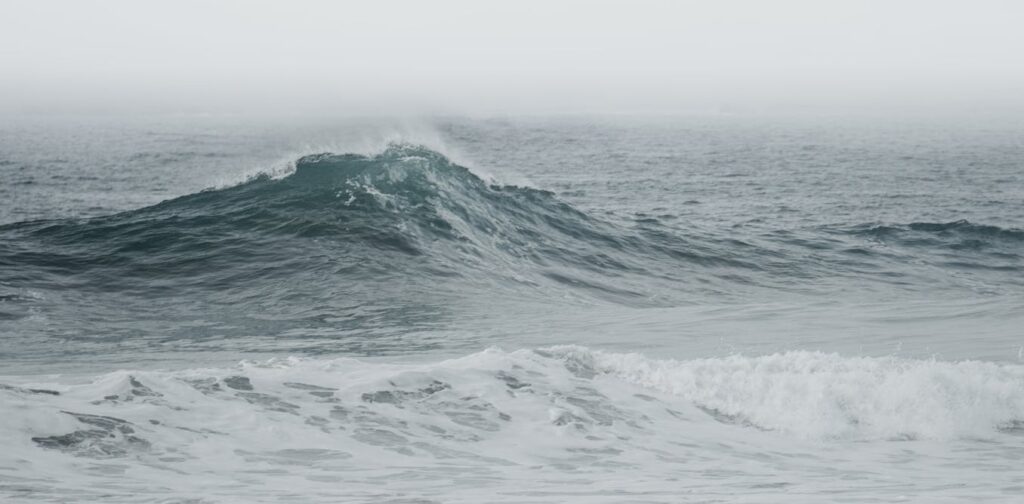
Rogue waves have long captured the fascination of both seafarers and scientists. These colossal, isolated waves emerge unexpectedly in the open ocean, reaching heights of 65 feet (20 meters) or more, and often exceeding twice the height of surrounding waves. Once dismissed as nautical myths, rogue waves have been documented worldwide, posing significant threats to ships and offshore structures.
In an effort to demystify these oceanic giants, an international team of researchers, including myself, embarked on a comprehensive study. Our findings, published in Nature Scientific Reports, leverage an extensive dataset to challenge existing perceptions of rogue waves and uncover their origins.
Analyzing 18 Years of Ocean Data
Our research utilized 18 years of high-frequency laser measurements from the Ekofisk oil platform in the central North Sea. This dataset, the largest of its kind, provided nearly 27,500 half-hour wave records, or sea states, collected between 2003 and 2020. These records capture the sea surface elevation relative to the average sea level and include major storm events, such as the Andrea wave event in 2007.
Under typical conditions, waves form as wind blows over the sea surface, akin to ripples forming when one blows over a cup of coffee. Given sufficient time and space, these ripples can evolve into large waves. Our focus was on understanding the conditions under which waves transform into rogue waves, rising dramatically above their neighbors.
Debunking the Modulational Instability Theory
One prevailing theory, modulational instability, suggests that rogue waves result from complex mathematical phenomena. However, our study challenges this notion. While modulational instability may describe wave behavior in confined channels, it fails to account for rogue waves in the open ocean, where waves propagate from multiple directions.
To illustrate, consider a crowd exiting a stadium. If confined to a narrow hallway, people move in a single direction, potentially piling up like rogue waves. Conversely, an open field allows for free movement and dispersion, preventing such pileups. Similarly, rogue waves generated in laboratory channels adhere to modulational instability, but this does not hold true in the vast, open ocean.
Constructive Interference: A New Perspective
Our analysis revealed that rogue waves are more likely formed through constructive interference, rather than modulational instability. Constructive interference occurs when multiple waves align and combine into a single, massive wave. This process is amplified by the natural asymmetry of sea waves, where crests are sharper and steeper than troughs.
Rogue waves materialize when numerous smaller waves converge, their steep crests stacking to create a towering wave that briefly dominates its surroundings. This phenomenon follows a quasi-deterministic pattern, marked by recognizable and repeatable sequences with elements of randomness.
The Quasi-Deterministic Nature of Rogue Waves
Rogue waves are not exclusive to the ocean. Constructive interference can occur in various wave systems, as explained by oceanographer Paolo Boccotti’s theory of quasi-determinism. This theory elucidates how rogue waves form across different environments, including turbulent water in confined channels, where rogue waves manifest as intense, short-lived vortices.
Applying Boccotti’s theory to our North Sea data, we identified distinct patterns in the wave records. The giant waves observed carried a unique signature, or fingerprint, in the form of wave groups. These groups, akin to small packages of waves, rise, peak, and fade through constructive interference, offering insights into the genesis of rogue events.
“Recognizing how rogue waves form can help engineers and designers build safer ships and offshore platforms – and better predict risks.”
A Case Study: The November 2023 Storm
On November 24, 2023, a powerful storm struck the North Sea, captured by a camera at the Ekofisk platform. This event included a massive 55-foot (17-meter) rogue wave. By applying quasi-determinism and an AI model, we traced the wave’s origin to multiple smaller waves stacking together, confirming our theories of constructive interference.
Implications for Maritime Safety
Understanding the formation of rogue waves holds significant implications for maritime safety. Insights from our study can guide the design of more resilient ships and offshore platforms, enhancing their ability to withstand these formidable oceanic forces. Moreover, improved predictive models can help mitigate risks associated with rogue waves, safeguarding both human lives and valuable infrastructure.
As our understanding of rogue waves deepens, the potential for innovation and safety advancements grows. By continuing to explore the complexities of the ocean, we can better anticipate and adapt to its unpredictable nature, ensuring safer seas for all who navigate them.







